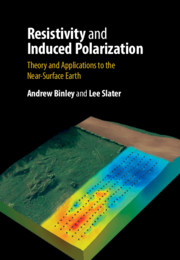Book contents
- Resistivity and Induced Polarization
- Reviews
- Resistivity and Induced Polarization
- Copyright page
- Contents
- Preface
- Acknowledgements
- Symbols
- 1 Introduction
- 2 Electrical Properties of the Near-Surface Earth
- 3 Instrumentation and Laboratory Measurements
- 4 Field-Scale Data Acquisition
- 5 Forward and Inverse Modelling
- 6 Case Studies
- 7 Future Developments
- Appendix A Modelling Tools
- References
- Index
- Plate Section (PDF Only)
1 - Introduction
Published online by Cambridge University Press: 17 December 2020
- Resistivity and Induced Polarization
- Reviews
- Resistivity and Induced Polarization
- Copyright page
- Contents
- Preface
- Acknowledgements
- Symbols
- 1 Introduction
- 2 Electrical Properties of the Near-Surface Earth
- 3 Instrumentation and Laboratory Measurements
- 4 Field-Scale Data Acquisition
- 5 Forward and Inverse Modelling
- 6 Case Studies
- 7 Future Developments
- Appendix A Modelling Tools
- References
- Index
- Plate Section (PDF Only)
Summary
The development of resistivity and induced polarization (IP) methods is often attributed to the experiments and observations of Conrad Schlumberger in the 1920s. In this chapter, we trace the origins of the methods further back in time to some of the earliest geophysical studies in mineral exploration and agriculture. We provide a comprehensive historical narrative of the development of the techniques over the last 100 years, drawing from both publications and patent applications in Europe, the USA and Russia. We explain the value of electrical measurements of the near-surface Earth, being the motivation for these developments over the last century. Major transitions in the understanding of the petrophysical relationships between electrical properties and the physical and chemical properties of the subsurface are highlighted. We also identify major technological advances in the instrumentation, data-acquisition techniques and data-processing strategies. We introduce the most recent methodological developments that pave the way for a new generation of resistivity and IP imaging applications, including fully 3D imaging across complex terrain and long-term automated monitoring of environmental processes in the near-surface.
- Type
- Chapter
- Information
- Resistivity and Induced PolarizationTheory and Applications to the Near-Surface Earth, pp. 1 - 17Publisher: Cambridge University PressPrint publication year: 2020



